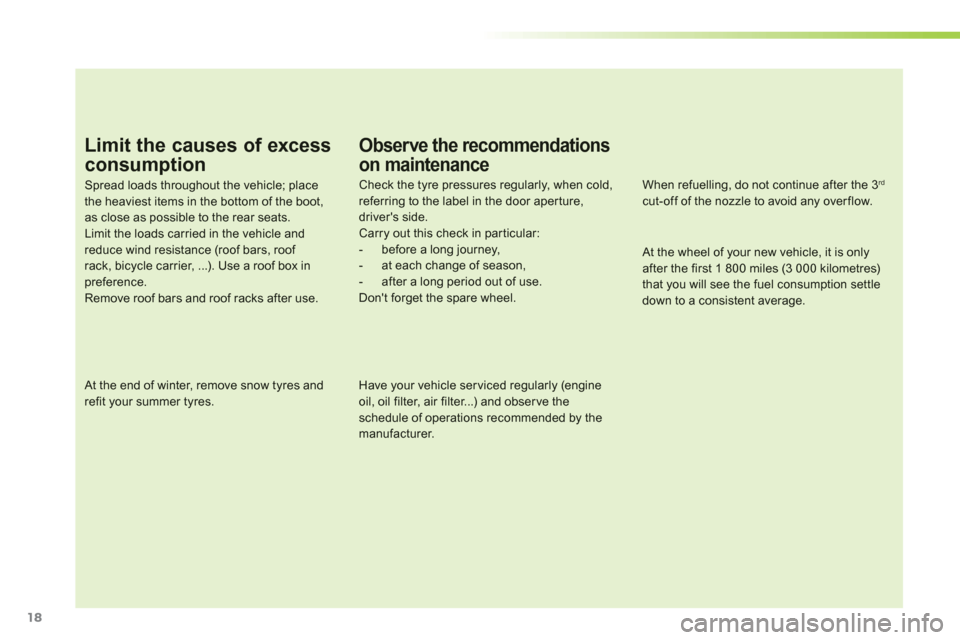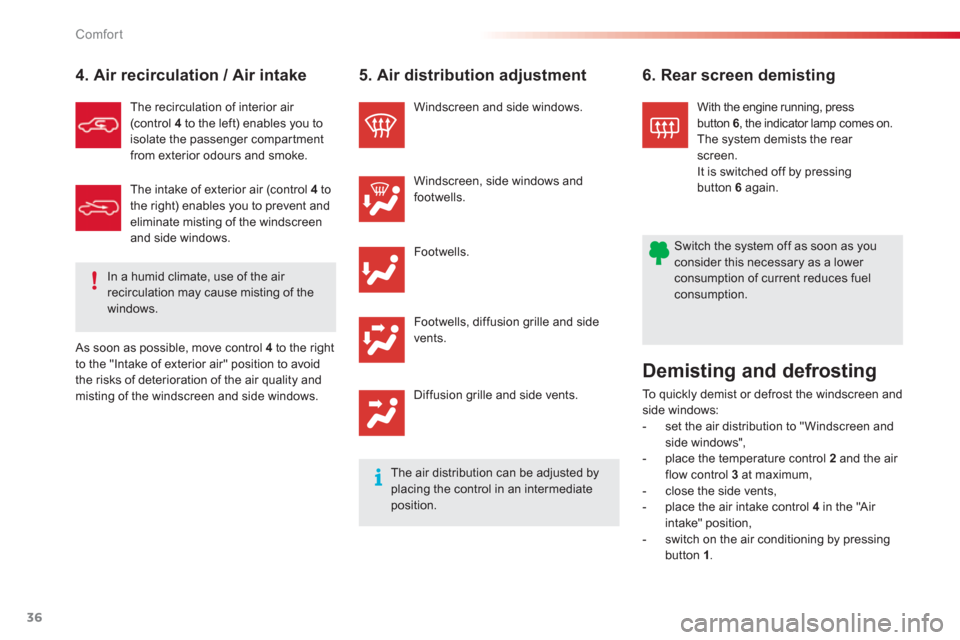fuel consumption Citroen C1 RHD 2012 1.G Owner's Manual
[x] Cancel search | Manufacturer: CITROEN, Model Year: 2012, Model line: C1 RHD, Model: Citroen C1 RHD 2012 1.GPages: 140, PDF Size: 4.2 MB
Page 19 of 140

.
17
Eco-driving
Eco-driving is a range of everyday practices that allow the motorist to optimise their fuel consumption and CO2 emissions.
Optimise the use of your
gearbox
With a manual gearbox, move off gently, change up without waiting and drive by changing up quite soon.
With the electronic gearbox stay in Easy "E"without pressing the accelerator pedal heavily or suddenly.
Drive smoothly
Maintain a safe distance between vehicles, use engine braking rather than the brake pedal, and press the accelerator progressively. These practices contribute towards a reduction in fuel consumption and CO2 emissions and also helps reduce the
background traffic noise.
Control the use of your electrical equipment
Before moving off, if the passenger compartment is too warm, ventilate it byopening the windows and air vents before using the air conditioning.
Above 30 mph (50 km/h), close the windowsand leave the air vents open. Remember to make use of equipment that canhelp keep the temperature in the passenger compartment down (sun blinds, ...).Switch off the air conditioning as soon as the desired temperature is attained.Switch off the demisting and defrosting controls, if not automatic.
Switch off the headlamps and the foglamp whenthe level of light does not require their use.
Avoid running the engine before moving off,particularly in winter; your vehicle will warmup much faster while driving.
As a passenger, if you avoid connecting your multimedia devices (film, music, video game...), you will contribute towards limitingthe consumption of electrical energy, and soof fuel.
Disconnect your por table devices beforeleaving the vehicle.
Page 20 of 140

18
Limit the causes of excess
consumption
Spread loads throughout the vehicle; placethe heaviest items in the bottom of the boot,as close as possible to the rear seats.Limit the loads carried in the vehicle andreduce wind resistance (roof bars, roof rack, bicycle carrier, ...). Use a roof box inpreference.Remove roof bars and roof racks after use.
At the end of winter, remove snow tyres and refit your summer tyres.
Observe the recommendations
on maintenance
Check the tyre pressures regularly, when cold, referring to the label in the door aper ture, driver's side.
Carry out this check in par ticular:
- before a long journey,
- at each change of season,
- after a long period out of use.
Don't forget the spare wheel.
Have your vehicle ser viced regularly (engine oil, oil filter, air filter...) and obser ve the schedule of operations recommended by themanufacturer.
When refuelling, do not continue after the 3rd
cut-off of the nozzle to avoid any overflow.
At the wheel of your new vehicle, it is onlyafter the first 1 800 miles (3 000 kilometres) that you will see the fuel consumption settle down to a consistent average.
Page 36 of 140

34Comfort
Heating
1. Temperature adjustment
Turn the control from blue (cold) to red(hot) to adjust the temperature to suit your requirements.
2. Air fl ow adjustment
When the ignition is switched on, turn the control to obtain a flow of air which is sufficient
to ensure your comfort.
To maintain a certain level of comfort in thepassenger compar tment, avoid position 0whenever possible.
In position 0, a slight flow of air, due to themovement of the vehicle, can still be felt. Win
dscreen and side windows.
4. Rear screen demisting
With the engine running, press button 4
, the indicator lamp comes on.
The system demists the rear screen.
It is switched off b
y pressing control 4
.
3. Air distribution adjustment
Footwells, diffusion grille and side
vents.
Di
ffusion grille and side vents.
Demisting and defrosting
To quickly demist or defrost the windscreen and side windows:
- set the air distribution to "Windscreen and side windows",
- place the temperature control 1
and the air
fl
ow control 2at maximum,
- close the side vents.
The air distribution can be adjusted byplacing the control in an intermediate
position.
Switch the system off as soon as you consider this necessary as a lower consumption of current reduces fuel consumption.
Windscreen, side windows and
f
ootwells.
Footwells.
Page 38 of 140

36Comfort
Footwells.
4. Air recirculation / Air intake
The recirculation of interior air (control 4to the left) enables you to
isolate the passenger compartment
from exterior odours and smoke.
5. Air distribution adjustment
Windscreen and side windows.
Windscreen, side windows andfootwells.
Footwells, diffusion
grille and side
vents.
Di
ffusion grille and side vents.
6. Rear screen demisting
As soon as possible, move control 4
to the right
to the "Intake of exterior air" position to avoid
the risks of deterioration of the air qualit
y and misting of the windscreen and side windows. The intake of exterior air
(control 4
tothe right) enables you to prevent and eliminate misting of the windscreenand side windows. With the en
gine running, pressbutton 6
, the indicator lamp comes on.
The system demists the rear screen.
It is switched off by pressingbutton 6again.
Demisting and defrosting
To quickly demist or defrost the windscreen and side windows:
- set the air distribution to "Windscreen and side windows",
- place the temperature control 2
and the air
flow control 3at maximum,
- close the side vents,
- place the air intake control 4
in th
e "A ir
intake" position,
- sw
itch on the air conditioning by pressing button 1.
Switch the system off as soon as you consider this necessary as a lower consumption of current reduces fuel consumption.
The air distribution can be adjusted by placing the control in an intermediate position.
In a humid climate, use of the air recirculation may cause misting of thewindows.
Page 94 of 140

Technical data
92
Identifi cation markings
B. Vehicle Identifi cation Number.
This is engraved on the crossmember, under
the front right seat.
A. Manufacturer's plate.
1.
EU approval number. 2.
Vehic le Identification Number (VIN).3.
Gross vehicle weight.4.
Gross train weight.5.
Maximum weight on front axle.
6.Maximum weight on rear axle.7. Paint colour reference.
5-door
3-door
C. T
yres.
The label Caffixed to the pillar, near the left
door striker, indicates:
- the t
yre sizes,
- the t
yre pressures.
The tyre pressures must be checkedwhen cold, at least once a month.
If the tyre pressures are too low, this increases fuel consumption.
Page 136 of 140

134Alphabetical index
Keeping children safe .......................28,57, 63Key................................................................26
Lighting bulbs (replacement)..................67, 68Lighting control stalk.....................................44Lighting on reminder.....................................r44Loading..........................................................17Locating your vehicle ....................................26Locking/unlocking a door from the inside.....28
Main beam........................................44, 67, 68Maintenance............................................17,85Manual mode................................................42Mat................................................................79Mini fuel level ..........................................23, 30Mirror, rear view............................................37Mirrors, door..................................................r37Mountings for ISOFIX seats ......................... 62MP3 CD .................................................99, 100
Number plate lamps ......................................70
K
M
N
Filling with fuel ........................................30,31Fitting a wheel ...............................................65Flashing indicators .............................44, 67-70Folding/unfolding the door mirrors................37Force limiter..................................................r51Front foglamps........................................44, 68Front seats....................................................38Fuel..............................................17, 23,30,31Fuel consumption..............................17, 23, 30Fuel gauge ..............................................23, 30Fuel tank..................................................23, 30Fuses .............................................................71
Gearbox, electronic.......................................88Gearbox, manual ..........................................88Gearbox, manual (reverse gear)...................16Gear lever......................................................17Gear lever, electronic gearbox system.........88
Identification..................................................92Identification plates.......................................92Inflating tyres................................................17Instrument panel...........................................19Instrument panel fusebox .............................71Interior fittings ...............................................40Interior lamp..................................................46ISOFIX.....................................................62, 64ISOFIX child seats..................................63, 64ISOFIX mountings...................................62, 64
Hands-free kit.............................................. 104Headlamp adjustment................................... 44Headlamp flash.............................................44Headlamps........................................44, 67, 68Head restraints, rear.....................................r39Heating........................................12, 13, 17,34
Jack ...............................................................65JACK socket..................................................40
F
H
G
I
J
Lamps, front ......................................44,67,68Lamps, rear.......................................r44, 69,70LED daytime running lamps..........................45Level, brake fluid...........................................86Levels and checks...................................86,87Lighting....................................................44,68
L
Oil filter..........................................................r88Oil level ..........................................................86Opening the bonnet......................................84Opening the boot ..........................................29
O